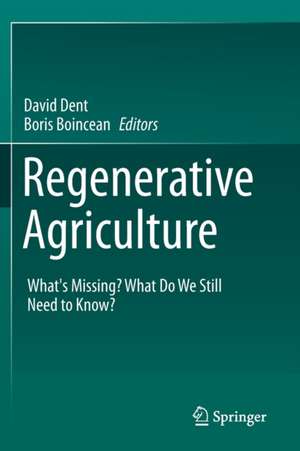Regenerative Agriculture: What’s Missing? What Do We Still Need to Know?
Editat de David Dent, Boris Boinceanen Limba Engleză Paperback – 23 iun 2022
Regenerative agriculture builds on known knowns – like crop rotation, water and nutrient requirements, soil and water conservation, farm-gate prices, international trade and supply chains. It grapples with known unknowns – like weed, pest and disease control without agrochemicals, cover crops for profit as well as protection, mitigating and adapting to the climate crisis, resilience and tipping points in ecosystems, farming systems and societies,and how we can pay for imperative changes. Lastly, it acknowledges unknown unknowns – the things we are oblivious to but which we really must know – like how to liberate the ghettos of the mind inhabited by farmers, agronomists, politicians and societies.
| Toate formatele și edițiile | Preț | Express |
|---|---|---|
| Paperback (1) | 1788.81 lei 6-8 săpt. | |
| Springer International Publishing – 23 iun 2022 | 1788.81 lei 6-8 săpt. | |
| Hardback (1) | 1797.20 lei 3-5 săpt. | |
| Springer International Publishing – 22 iun 2021 | 1797.20 lei 3-5 săpt. |
Preț: 1788.81 lei
Preț vechi: 2181.48 lei
-18% Nou
Puncte Express: 2683
Preț estimativ în valută:
342.44€ • 352.19$ • 284.09£
342.44€ • 352.19$ • 284.09£
Carte tipărită la comandă
Livrare economică 17 februarie-03 martie
Preluare comenzi: 021 569.72.76
Specificații
ISBN-13: 9783030722265
ISBN-10: 3030722260
Ilustrații: XIX, 355 p. 72 illus., 56 illus. in color.
Dimensiuni: 155 x 235 mm
Greutate: 0.53 kg
Ediția:1st ed. 2021
Editura: Springer International Publishing
Colecția Springer
Locul publicării:Cham, Switzerland
ISBN-10: 3030722260
Ilustrații: XIX, 355 p. 72 illus., 56 illus. in color.
Dimensiuni: 155 x 235 mm
Greutate: 0.53 kg
Ediția:1st ed. 2021
Editura: Springer International Publishing
Colecția Springer
Locul publicării:Cham, Switzerland
Cuprins
The Cost of Food, Consequences of not valuing soil, water and those who manage them.- Changing the Paradigm of agricultural intensification. Challenges faced by agriculture in Moldova.- The Alberta Experience. Climate change action plan, cap-and-trade legislation for carbon emissions, and carbon credits for farmers.- The Social Food Service market – a lever for change.- Discussion.- Is the future of Agriculture Perennial? The fundamental difference between natural ecosystems and agro-ecosystems.- Managing chernozem to achieve Sustainable Development Goals.- Quality and health of anthropically transformed Black Earth.- Seeking an alternative for weed control in Conservation Agriculture.- Step-by-step to fill the gaps along the path to sustainability.- Discussion.- Agricultural Research and the Agriculture of the Future.- The LONE Concept, Agriculture of the Future.- Adaptation to climate change through plant breeding: the status of winter wheat.- Long-term research on crop rotation.- Sustainable intensification of agriculture on the Bălţi steppe. Crop diversity, irrigation, and no-till in crop rotations.- Restoration of the degraded plough layer of Chernozem prior to implementation of Zero Tillage.- The Big Picture - some ideas for research and action: an International Hydrological Network for Food-water; needs and opportunities for financing regenerative agriculture across the steppes through Green Bonds.- Pointers for decision-makers, researchers and practical farmers.
Notă biografică
Boris Boincean knows the black earth. As a son of the steppe, he has spent his professional life cheek by jowl with chernozem. He holds the degree of Dr Hab. agricultural sciences from Moscow Timireazev Akademy (University) and, for many years, has directed the long-term field experiments at the Selectia Research Institute for Field Crops on the Bălţi Steppe, in Moldova - the very soil described by Dokuchaev in 1887 as 'first class'. He also holds the Chair of Natural Resources and Agro-ecology at Alecu Russo Bălţi State University.
Textul de pe ultima copertă
The food system is our last coal-fired power station, our last diesel engine. This book is a trans-disciplinary treatment of what needs to be done to make it not only sustainable but also to regenerate soil and water resources, habitat, economy and society. The book brings back classical principles of agronomy and integrates economic, agro-ecological and social perspectives, drawing on a wealth of expertise on the political economy of the food system, Conservation Agriculture, and long-term field experiments.
Regenerative agriculture builds on known knowns – like crop rotation, water and nutrient requirements, soil and water conservation, farm-gate prices, international trade and supply chains. It grapples withknown unknowns – like weed, pest and disease control without agrochemicals, cover crops for profit as well as protection, mitigating and adapting to the climate crisis, resilience and tipping points in ecosystems, farming systemsand societies, and how we can pay for imperative changes. Lastly, it acknowledges unknown unknowns – the things we are oblivious to but which we really must know – like how to liberate the ghettos of the mind inhabited by farmers, agronomists, politicians and societies.
Regenerative agriculture builds on known knowns – like crop rotation, water and nutrient requirements, soil and water conservation, farm-gate prices, international trade and supply chains. It grapples withknown unknowns – like weed, pest and disease control without agrochemicals, cover crops for profit as well as protection, mitigating and adapting to the climate crisis, resilience and tipping points in ecosystems, farming systemsand societies, and how we can pay for imperative changes. Lastly, it acknowledges unknown unknowns – the things we are oblivious to but which we really must know – like how to liberate the ghettos of the mind inhabited by farmers, agronomists, politicians and societies.
Caracteristici
A vade mecum for climate-smart, sustainable agriculture Draws on vast international, practical experience set in today’s policy context Wide-ranging yet clearly focussed on today’s issues of agriculture and the environment, from soil and water management and climate change to farm-gate prices and the power relations of consumers, corporates, politicians, and farmers
